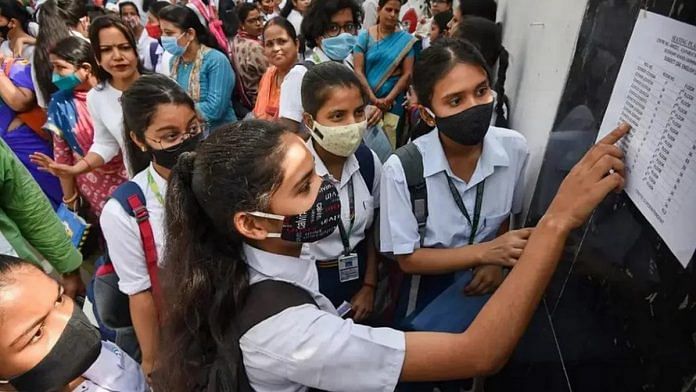New Delhi: Teachers who believe boys are better than girls at mathematics may negatively affect the scores of their female students, according to a new study by Indian researchers.
Due to be published this March in the Journal of Development Economics, an international peer-reviewed publication, the study found that gender bias on the part of teachers had a detrimental impact not just on girls’ performance in maths, but their confidence and attitude towards the subject.
However, no significant effect of English teachers’ gender bias was found in the English learning of students.
To arrive at their findings, the researchers — Sonali Rakshit from Arizona State University and Soham Sahoo from the Indian Institute of Management (IIM) Bangalore — looked at matched student-teacher data of over 9,000 Class 9 pupils from 205 schools in Andhra Pradesh and Telangana, collected by the 2016-2017 Young Lives survey, an international longitudinal study of childhood poverty.
In the Young Lives survey, each teacher was asked questions relating to their beliefs about how students’ gender, caste, and class affected their performance. Rakshit and Sahoo used this data to create their own gender bias index for teachers. They then compared the actual performance of boys and girls taught by teachers who had varying levels of biased beliefs. In order to understand the progress of students’ performance, test scores from the beginning and end of the academic year were used.
The study also looked at students’ non-cognitive outcomes such as attitude towards maths and English, academic self-confidence, study effort, learning motives, and classroom instructional environment.
The researchers used a value-added model, or statistical methods that employed a baseline score for students and accounted for factors like the teacher’s background, training, content knowledge, and so on.
“We find that there is a significant gender gap (in favour of boys) in mathematics achievement among secondary school students, and this gap increases over an academic year,” the researchers wrote.
Speaking to ThePrint, Sahoo explained that the study was conducted to build upon existing research on the “female disadvantage” in mathematics.
“The study was conducted to understand the role of teachers on secondary school students’ learning outcomes. Existing studies show female disadvantage in maths learning when they become adolescents, so we wanted to explore if teachers play any role, and especially if teachers’ subjective beliefs play any role,” he said.
The issue of poor learning outcomes in mathematics for female students is a well-recognised issue in the Indian education system. This in the longer run also negatively impacts the kind of higher education and income opportunities that are available to women.
The Ministry of Education’s 2021 National Achievement Survey (NAS), published in May last year, highlighted that mathematics learning outcomes among girls and boys widen as they reach higher classes.
The survey found that girls and boys are at an almost level playing field in mathematics in Class 3, but by the time they reach Class 10, boys in most parts of the country significantly outperform girls in the subject. This, however, was not the case for English in the NAS survey, where girls were found to outperform boys in Class 10.
Also read: More women students now study STEM courses in IITs, NITs & other universities, shows govt data
Why is English different?
On their finding that teacher bias did not have a significant bias on English scores, Rakshit and Sahoo observed in the study that it was consistent with other research that though there was a maths gender gap among adolescents in various parts of the world, girls were at par with or even better than boys at learning languages.
They added that due to the wider prevalence in society of stereotypes against girls’ mathematical ability, female students “may be more susceptible” to teachers’ biases while studying maths rather than English.
“Math teachers may also be more expressive of their stereotypical behaviour than language teachers in the classroom,” the researchers said.
What makes a teacher more likely to be biased?
Using statistical methods, the researchers did not find a significant correlation between teachers’ bias and their gender, social category, and years of experience.
However, the findings suggested that teachers with professional qualifications such as a B.Ed or M.Ed degree, ability to converse in English, higher wealth, and full-time employment exhibited “significantly lower” gender bias, especially in the case of maths teachers.
“We find that teachers’ gender bias is significantly negatively correlated with their professional commitment, morale and satisfaction within the current job, and teaching efficacy,” the researchers further noted.
Caste biases
In a separate analysis, the researchers investigated whether teachers’ caste bias had any impact on student’s learning outcomes, but did not find a significant effect.
The researchers surmised that this could be due to various factors, including the fact that the difference between the average baseline maths scores of two caste groups was considerably larger than the gender gap.
“If backward caste students are lagging far behind, the relative importance of stereotypical attitude of teachers may be lower than other hurdles they face; thus, the effect of teacher’s caste bias may not have a significant effect on caste gap in math learning,” the researchers wrote.
(Edited by Asavari Singh)
Also read: Why Indian parents are shifting kids to govt schools, but spending more on private tutors



